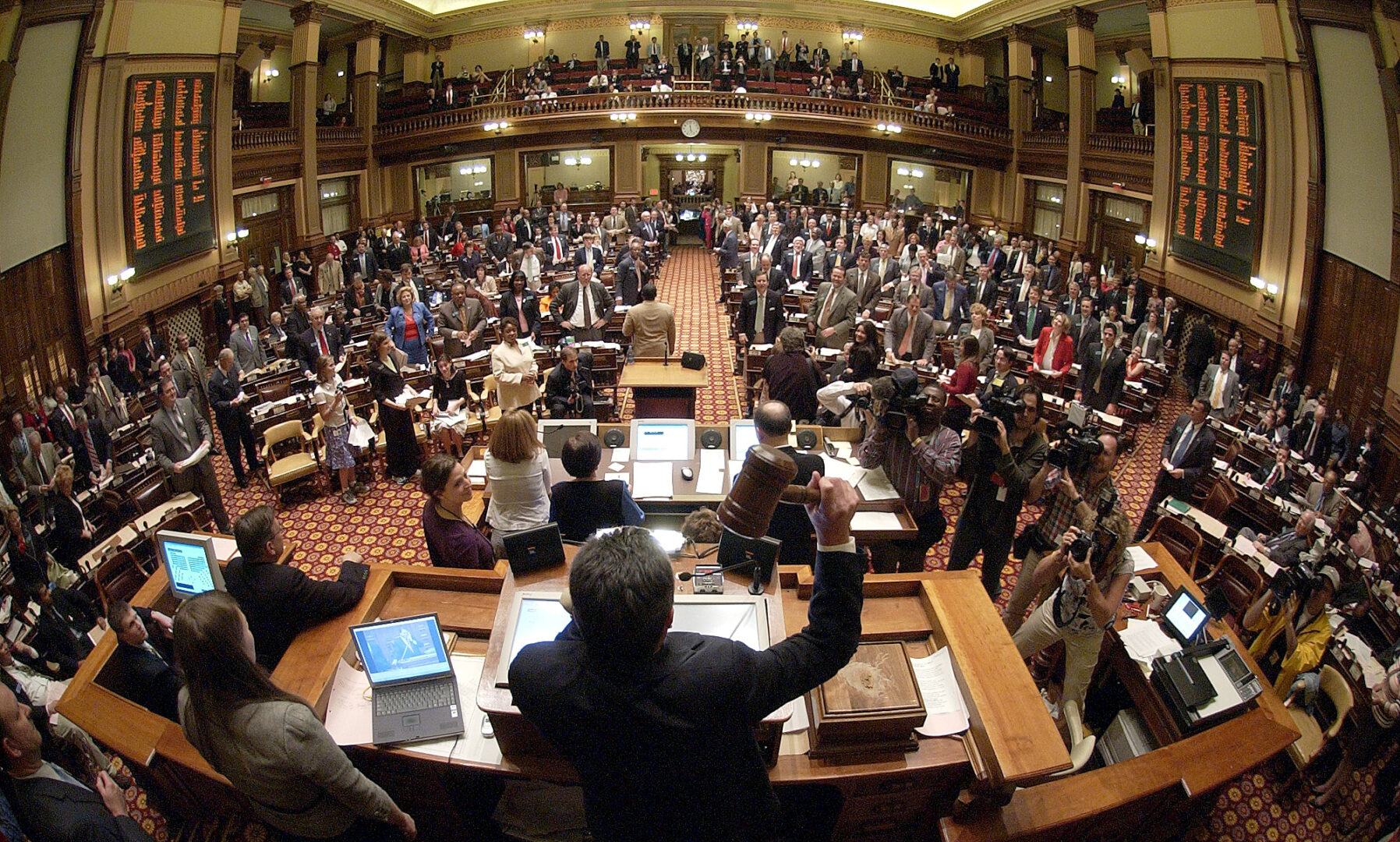Origins of State Government
Georgia, the thirteenth British colony to be created, was chartered by King George II in 1732 and put under the governance of twenty-oneTrustees. In a unique experiment in altruism, the Trustees adopted the Latin motto Non sibi sed aliis (“Not for self, but for others”) as they crafted rules and regulations to shape the colony into a utopia where there would be no social classes and colonists would succeed by their own efforts and hard work. Nearly twenty years later—and only one year away from turning the colony back to the king—the Trustees permitted Georgia colonists to experience representative government for the first time. Sixteen elected delegates met in Savannah in 1751 to discuss and relay their concerns about the colony to the Trustees.
Georgians were again given the opportunity to participate in governing after Georgia became a royal colony. Through the Commons House of Assembly, white males owning at least 500 acres of land could be elected and pass laws for the colony. Their voice was muted by the fact that either the royal governor or the king could veto any laws.
The independence movement and the American Revolution (1775-83) enabled colonists to set the foundations of state government. Before the Declaration of Independence was drafted, Georgia patriots organized a Provincial Congress to work with other colonies in winning independence. In April 1776 the congress adopted a temporary constitution called the Rules and Regulations. Its preamble made it clear that government rested upon the will of the people. Georgia’s first constitution, written the following year, included the principle of separation of powers in its first article. Although three branches of government were created, power was concentrated in a unicameral legislature, leaving the governor with little executive power.
During the Revolution the Articles of Confederation established a union of states, including Georgia, which ultimately proved ineffective as a system of national government. Georgia acted quickly in 1788 and became the fourth state to ratify the U.S. Constitution and join the federal system of government. The Constitution was recognized as the supreme law of the land, but under the federal system certain powers were granted exclusively to the national government (for example, coining money and national defense) or to the states (for example, creating local governments and regulating marriages and divorces). At the same time, some powers, such as taxation and adopting criminal codes, were granted to both levels of government.
Government Milestones
Several milestones mark the development of Georgia’s state government. Some have influenced or resulted in changes in the governments of other states as well. As a result of the Yazoo land fraud in 1795 (a land deal was passed that practically gaveaway Georgia’s western lands), Georgia developed a new constitutional requirement for legislation. Because no mention of the land deal was made in the Yazoo bill’s title—its introductory summary—it passed without public knowledge of the bill’s real intent. Consequently, the new Georgia Constitution of 1798 and every constitution since has included a provision that the subject matter of a bill must be mentioned in the title. Georgia was the first state to enact a constitutional provision governing the title and the content of bills, and many other state constitutions would follow this innovation. The popular election of the governor by the people in 1825 was another state government milestone. Before that time the General Assembly elected the governor, but a constitutional amendment transferred that right to the voters. In 1868 Georgia voters were given, for the first time, the opportunity to ratify amendments to the state constitution.
In 1917 the General Assembly enacted a new plan for counting Democratic primary votes in the election for governor and Georgia’s national senators. The county unit system, as it was called, was designed to keep power from shifting from rural areas to the growing urban areas. Challenges to the county unit system went to the U.S. Supreme Court, which in
Throughout the mid-1960s challenges were made to the legislative apportionment method that based representation on county jurisdictional boundaries and not on population. The General Assembly was ordered to redraw legislative districts solely on the basis of population. This had the effect of diversifying the General Assembly as its members more closely reflected the state’s demographic characteristics. Consequently, African Americans, women, and members of the Republican Party were elected to the General Assembly. The urban-rural balance changed as well.
Structure of Georgia Government
In Georgia the executive branch of government is by far the largest, with 99 percent of the state budget devoted to its activities. The governor is the state’s chief executive and presides over the executive branch. In doing so, the governor wields strong budgetary powers. To be elected governor, a person must be at least thirty years old and must have been a U.S. citizen for fifteen years and a Georgia resident for six years. Governors serve a four-year term of office and may serve no more than two consecutive terms.
The Georgia Constitution names seven other executive officers elected statewide by the voters. They are the lieutenant governor, secretary of state, attorney general, commissioner of agriculture, commissioner of labor, commissioner of insurance, and state school superintendent. In addition, members of the Georgia Public Service Commission are elected statewide. These officers, along with other heads of state departments, agencies, commissions, and boards, administer departments that directly address areas of importance to state government. The name of the agency generally indicates its work: the Georgia Bureau of Investigation, Forestry Commission, Department of Transportation, or Department of Community Health. There are more than twenty-five major departments in the executive branch and hundreds of smaller agencies, boards, and commissions.
The General Assembly and its staff agencies form the legislative branch of state government. The bicameral legislature consists of a House of Representatives and a senate. Members of both houses are elected for two-year terms with no limit on the number of consecutive terms that may be served. The Georgia Constitution requires legislators to be U.S. citizens, Georgia citizens for at least two years, and legal residents of their districts for at least one year. The only difference in qualifications between the two chambers is that senators must be at least twenty-five years of age and representatives only twenty-one. The house has 180 members, who elect their presiding officer, the Speaker. The senate has fifty-six members, and the lieutenant governor serves as its presiding officer. In that capacity the lieutenant governor is styled as the president of the senate. The General Assembly meets for a forty-day period each year, beginning on the second Monday in January. Because the legislative term is a biennium (a two-year period), legislation that is introduced in the first year after an election can be carried over to the second year. At the end of the second year, all legislation not passed dies and must be reintroduced in the next biennium.
Georgia’s judicial system consists of ascending levels of courts. The most important trial court in Georgia’s judicial branch is the superior court. The state is divided into circuits, with one or more superior-court judges elected in each circuit. In 1845 the Georgia Supreme Court was established as the highest court in the state. It has exclusive jurisdiction over constitutional issues, contested elections, capital felonies, titles to land, wills, and divorces. Later, in 1906, the Court of Appeals of Georgia was established to hear appeals, review decisions, and correct errors from lower trial courts in cases not reserved to the supreme court.
Local Government in Georgia
Local government is the oldest form of government in Georgia, and the city of Savannah is recognized as the oldest government in the state. There are three types of local governments in Georgia—counties, cities, and special districts. Georgia has four consolidated city-county governments. The constitution limits Georgia to 159 counties, although there is no limit on the number of cities and special districts.
County government is based in the county seat and generally housed in the county courthouse. Due to increases in population and service demands, many county governments are expanding operations into government annexes and satellite offices outside the county seat. As an arm of state government, county governments carry out many functions for the state, such as elections, road building and repair, health and welfare programs, record keeping, and automobile licensing. The state constitution requires that four officers be elected in each county: sheriff, clerk of the superior court, tax commissioner, and judge of the probate court. Local law establishes the county’s form of government, either a board of commissioners or a sole commissioner.
Cities are governments that have been chartered or incorporated by the state legislature. Generally, cities are formed when citizens want services provided beyond those available from the county. Cities must meet certain qualifications of population, distance from other cities, and degree of development. The city charter not only creates the city but also spells out the form of government and describes boundaries. Cities are typically governed by a mayor and city council. Many cities hire a manager to direct the day-to-day administration of city affairs. Georgia has more than 500 incorporated cities. By law, counties and cities must agree on the provision and payment of local government services to eliminate service duplication.
A more limited form of local government in Georgia is the special district or authority. These are small units of government set up by a county or city for a special purpose, such as operating public schools, a transit system, an airport, or a water and sewer system, or encouraging economic development. These units are authorized to borrow money or charge users for their services. By establishing an authority a city can make a service available to citizens without raising taxes.
Georgia’s constitution, like that of most states, requires that a balanced budget be introduced and passed by the General Assembly. The governor is responsible for submitting to the legislature an annual budget based on revenue estimates made by the Office of Planning and Budget. Because local governments are creatures of the state, state law controls their revenue sources. Property taxes, sales taxes, and utility revenue fees are major sources of income at the local level. Citizens of a locality may vote to impose additional local taxes to fund special projects for educational or other purposes.






